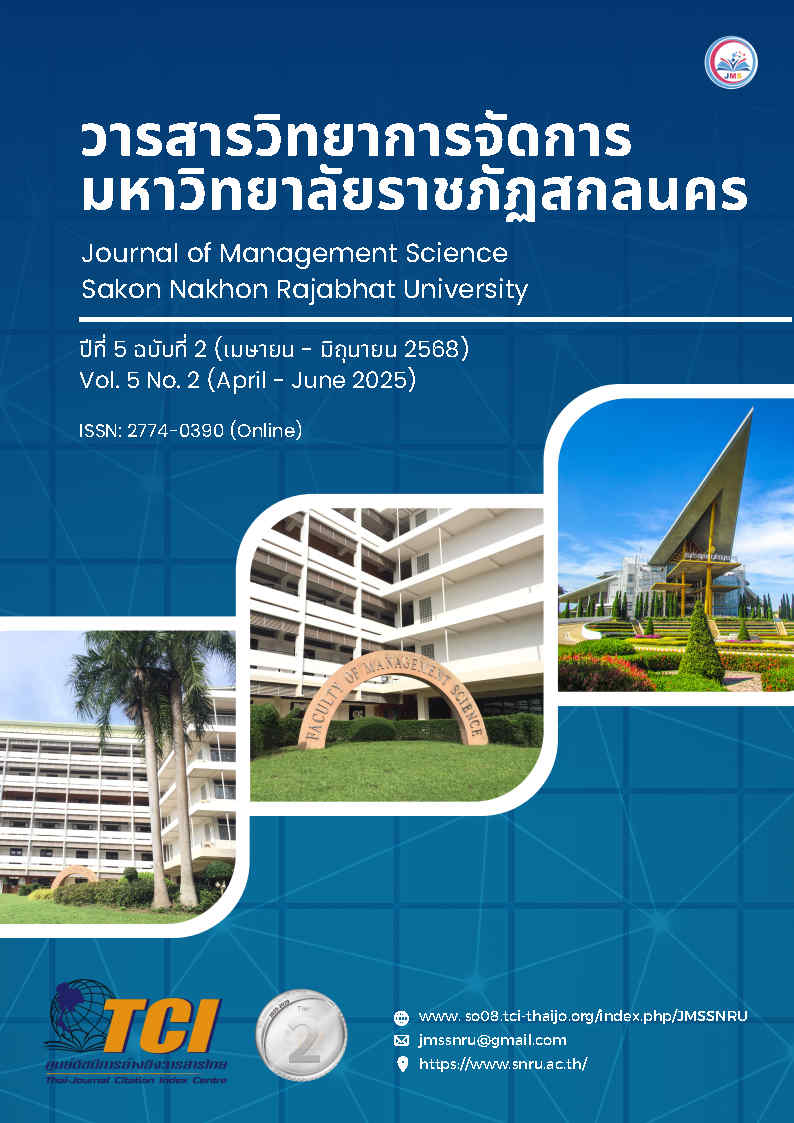The management of the bachelor of education curriculum in Innovation and Computer Education, Faculty of Education, Sakon Nakhon Rajabhat University
Keywords:
curriculum management, learning management, teaching profession, education curriculum, PDCA cycleAbstract
The objectives of this research were to 1) study the curriculum management model of the Bachelor of Education Program in Innovation and Computer Education at Sakon Nakhon Rajabhat University, 2) investigate the effectiveness of the curriculum management, and 3) explore the stakeholders’ opinions towards the curriculum management. The target group of this research consisted of stakeholders who participated in the curriculum design and development, categorized into three groups: program instructors, students, and employers of graduates. A total of 344 participants were selected through purposive sampling. Research instruments included interview form and questionnaire assessing opinions on curriculum management. The content validity of the questionnaires ranged from .67 to 1.00. The statistics used in the research included percentage and mean. The research showed that 1) the curriculum management model of the Bachelor of Education Program in Innovation and Computer Education at Sakon Nakhon Rajabhat University had four parts: 1.1) policies, principles and concepts, and the management of a quality curriculum that is efficient and effective, 1.2) management process that includes resources, following the PDCA cycle, and support for learning; 1.3) curriculum management effectiveness, and 1.4) complete educational plan for the entire program, 2) Regarding the effectiveness of curriculum management, the program was able to admit students according to the planned capacity. The graduation rate ranged from 85.71% to 94.29%, the dropout rate ranged from 5.71% to 16.67%, and the employment rate of graduates was 100%, and 3) The stakeholders’ opinions showed that instructors were highly satisfied, employers of graduates expressed the highest level of satisfaction, and students reported a high level of satisfaction overall.
References
กานต์ธิดา บุญมา. (2566). การพัฒนารูปแบบการเรียนการสอนที่ส่งเสริมทักษะทางปัญญา ตามกรอบมาตรฐานคุณวุฒิระดับอุดมศึกษาแห่งชาติ สำหรับนักศึกษาระดับปริญญาตรี มหาวิทยาลัยราชภัฏ. ดุษฎีนิพนธ์ปรัชญาดุษฎีบัณฑิต สาขาวิชาศึกษาศาสตร์ มหาวิทยาลัยสุโขทัยธรรมธิราช.
ขอบฟ้า จันทร์เจริญ, วราภรณ์ ไทยมา และภัทราวดี มากมี. (2564). แนวทางการผลิตนักศึกษาวิชาชีพครู มหาวิทยาลัยราชภัฏในภาคตะวันออกเฉียงเหนือ ตามมาตรฐานความรู้วิชาชีพครู ฐานสมรรถนะ. วารสารวิชาการคณะมนุษยศาตร์และสังคมศาสตร์, 12(1), 127-142.
คณะครุศาสตร์. (2562). หลักสูตรครุศาสตรบัณฑิต สาขาวิชานวัตกรรมและคอมพิวเตอร์ศึกษา. มหาวิทยาลัยราชภัฏสกลนคร.
บุญชม ศรีสะอาด. (2554). การวิจัยเบื้องต้น (พิมพ์ครั้งที่ 9). กรุงเทพฯ: สุวีริยาสาส์น.
ประกาศคณะกรรมการมาตรฐานการอุดมศึกษา. (2565, 9 กันยายน). รายละเอียดผลลัพธ์การเรียนรู้ตามมาตรฐานคุณวุฒิระดับอุดมศึกษา พ.ศ. 2565. ราชกิจจานุเบกษา. 139(พิเศษ 212 ง), 35-36.
ประกาศคณะกรรมการการอุดมศึกษา. (2552, 16 กรกฎาคม). แนวทางการปฏิบัติตามกรอบมาตรฐานคุณวุฒิระดับอุดมศึกษาแห่งชาติ พ.ศ. 2552. ราชกิจจานุเบกษา. 126(พิเศษ 125 ง), 17-19.
ภัทวรรณ์ ไชยภักดิ์. (2565). การพัฒนารูปแบบการประเมินสมรรถนะครูตามแนวศาสตร์พระราชา ของนักศึกษาครูในมหาวิทยาลัยราชภัฏโดยประยุกต์ใช้แนวทางการประเมินแบบทฤษฎีเป็นฐาน. วิทยานิพนธ์การศึกษาดุษฎีบัณฑิต สาขาวิชาวิจัยและประเมินผลการศึกษา มหาวิทยาลัยนเรศวร.
มนต์ชัย เทียนทอง. (2545). การออกแบบและพัฒนาคอร์สแวร์สาหรับบทเรียนคอมพิวเตอร์ช่วยสอน. ภาควิชาคอมพิวเตอร์ศึกษา คณะครุศาสตร์อุตสาหกรรม สถาบันเทคโนโลยีพระจอมเกล้าพระนครเหนือ.
ลิขิตกุล กุลรัตนรักษ์ และอัจฉรา ไชยูปถัมภ์. (2559). แนวทางการพัฒนาหลักสูตรสาขาวิชาครุศาสตร์/ศึกษาศาสตร์ ตามกรอบสมรรถนะของครูในเอเชียตะวันออกเฉียงใต้ในศตวรรษที่ 21. วารสารครุศาสตร์, 44(3), 176-193.
วิไล ธรรมวาจา และสมศิริ สิงห์ลพ. (2567). 3-ACTIVE: แนวทางการพัฒนาทักษะการเรียนรู้ของผู้เรียนในศตวรรษที่ 21. วารสารวิชาการมหาวิทยาลัยราชภัฏอุดรธานี, 12(2), 1-13.
วรปภา อารีราษฎร์. (2556). การพัฒนาซอฟต์แวร์ทางการศึกษา. มหาสารคาม: อภิชาติการพิมพ์.
ศศิณัฎฐ์ สรรคบุรานุรักษ์ และอติยศ สรรคบุรานุรักษ์. (2558). การบริหารจัดการหลักสูตรในศตวรรษที่ 21 ห้องเรียนที่กว้างเท่ากับโลก.วารสารวิชาการและวิจัยสังคมศาสตร์, 10(28), 1-14.
Ambrosetti, A., Knight, B. A., & Dekkers, J. (2014). Building capacity in mentoring new teachers: An action research model for professional learning. Australian Journal of Teacher Education, 39(7), 126-143. https://ro.ecu.edu.au/ajte/vol39/iss7/8/.
Best, J. W & Khan, J. V. (1998). Research in Education. (8th ed.). Boston: Allyn & Bacon.
Day, C. (2012). The new lives of teachers. Teacher Education Quarterly, 39(1), 7-26. https://www.jstor.org/stable/23479681.
Imai, M. (1986). Kaizen: The key to Japan's competitive success. New York: McGraw-Hill.
Izadinia, M. (2015). A review of research on student teachers’ professional identity. British Educational Research Journal, 41(4), 592-617. https://bera-journals.onlinelibrary.wiley.com/doi/10.1002/berj.3168
Mulder, M. (2017). Competence-Based Vocational and Professional Education: Bridging the Worlds of Work and Education. Springer. https://link.springer.com/book/10.1007/978-3-319-41713-4.
Stoll, L., Bolam, R., McMahon, A., Wallace, M., & Thomas, S. (2006). Professional learning communities: A review of the literature. Journal of Educational Change, 7(4), 221–258. https://link.springer.com/article/10.1007/s10833-006-0001-8.
Tondeur, J., van Braak, J., Ertmer, P. A., & Ottenbreit-Leftwich, A. (2017). Understanding the relationship between teachers’ pedagogical beliefs and technology use in education: A systematic review of qualitative evidence. Educational Technology Research and Development, 65, 555–575. https://link.springer.com/article/10.1007/s11423-016-9481-2.
Voogt, J., & Roblin, N. P. (2012). A comparative analysis of international frameworks for 21st century competences: Implications for national curriculum policies. Journal of Curriculum Studies, 44(3), 299-321. https://www.tandfonline.com/doi/full/10.1080/00220272.2012.668938.
Downloads
Published
How to Cite
Issue
Section
License
Copyright (c) 2025 JOURNAL OF MANAGEMENT SCIENCE SAKON NAKHON RAJABHAT UNIVERSITY

This work is licensed under a Creative Commons Attribution-NonCommercial 4.0 International License.
An article published in the Journal of Management Science. Sakon Nakhon Rajabhat University is the opinion, copyright and responsibility of the author of the work.







